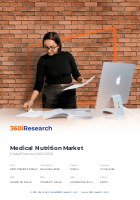
Medical Nutrition Market by Product Type (Enteral Nutrition, Oral Nutritional Supplements, Parenteral Nutrition), Age Group (Adults, Geriatric, Pediatric), Distribution Channel, Application - Global Forecast 2025-2030
SKU
MRR-0363DFE0366C
Region
Global
Publication Date
December 2025
Delivery
Immediate
2024
USD 50.39 billion
2025
USD 55.07 billion
2030
USD 88.76 billion
CAGR
9.89%

Download a Free PDF
Get a sneak peek into the valuable insights and in-depth analysis featured in our comprehensive medical nutrition market report. Download now to stay ahead in the industry! Need more tailored information? Ketan is here to help you find exactly what you need.



